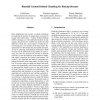Free Online Productivity Tools
i2Speak
i2Symbol
i2OCR
iTex2Img
iWeb2Print
iWeb2Shot
i2Type
iPdf2Split
iPdf2Merge
i2Bopomofo
i2Arabic
i2Style
i2Image
i2PDF
iLatex2Rtf
Sci2ools
FAST
2010
2010
Bimodal Content Defined Chunking for Backup Streams
Data deduplication has become a popular technology for reducing the amount of storage space necessary for backup and archival data. Content defined chunking (CDC) techniques are well established methods of separating a data stream into variable-size chunks such that duplicate content has a good chance of being discovered irrespective of its position in the data stream. Requirements for CDC include fast and scalable operation, as well as achieving good duplicate elimination. While the latter can be achieved by using chunks of small average size, this also increases the amount of metadata necessary to store the relatively more numerous chunks, and impacts negatively the system's performance. We propose a new approach that achieves comparable duplicate elimination while using chunks of larger average size. It involves using two chunk size targets, and mechanisms that dynamically switch between the two based on querying data already stored; we use small chunks in limited regions of t...
Comparable Duplicate Elimination | Duplicate Elimination | FAST 2010 | Operating System | Variable-size Chunks |
| Added | 02 Oct 2010 |
| Updated | 02 Oct 2010 |
| Type | Conference |
| Year | 2010 |
| Where | FAST |
| Authors | Erik Kruus, Cristian Ungureanu, Cezary Dubnicki |
Comments (0)

